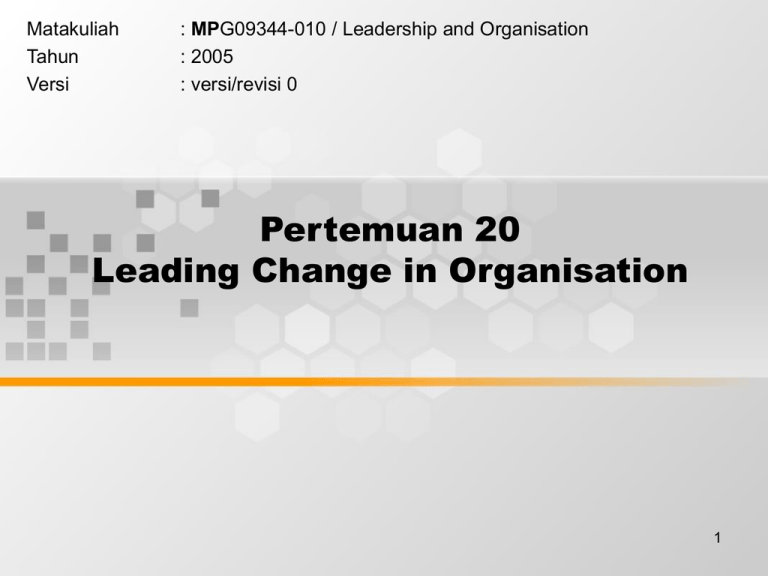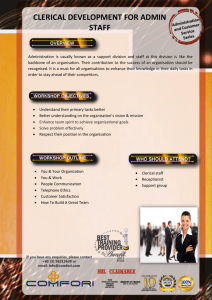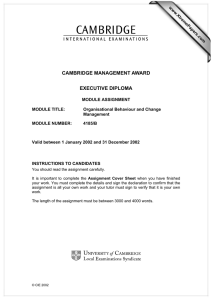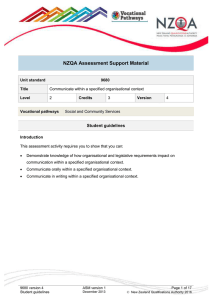Pertemuan 20 Leading Change in Organisation Matakuliah MP
advertisement

Matakuliah Tahun Versi : MPG09344-010 / Leadership and Organisation : 2005 : versi/revisi 0 Pertemuan 20 Leading Change in Organisation 1 Learning Outcomes After studying these chapters students should be able to: • Understand the different reasons for resisting change. • Understand the different types of organisational change. • Understand the psychological processes involved in making major changes in an organisation. • Understand the different ways that leaders can influence the culture of an organisation. • Understand the characteristics of an effective vision. • Understand how to develop an appealing vision for the organisation. • Understand the characteristics of a learning organization. • Understand how to increase learning and innovation in organisations. 2 Outline Materi Leading Change in Organisation • Change Processes • Different types of Organisational Change • Influencing Organisational Culture • Developing a Vision • Implementing a Change • Increasing Innovation and Learning • Summary • Review and Discussion Questions • Cases 3 Leading Change in Organisation 4 Different types of organizational change • Change attitudes or roles? • Technology • Competitive strategy • Importance of diagnosis 5 Influencing Organizational Culture • Nature of organizational culture • Primary ways to influence culture – Attention – Reaction to crisis – Role modeling – Allocation of rewards – Criteria for selection and dismissal • Secondary ways to influence culture – Design of systems and procedures 6 – Design of organization structure – Design of facilities – Stories, legends, and myths – Formal statements • Cultural forms • Culture and growth stages of organization 7 Developing a Vision • Desirable characteristics for a vision • Elements of a vision • Procedures for developing a vision – Involve key stakeholders – Identify strategic objectives with wide appeal – Identify elements in the old ideology – Link the vision to core competencies – Continually asses and refine the vision 8 Implementing change • Political or organizational actions – – – – – – – – Determine who can oppose or facilitate change Build a broad coalition to support the change Fill key positions with competent change agents Use task forces to guide implementation Make dramatic, symbolic changes that affect the work If necessary, begin on a small scale Change relevant aspects of the organization structure Monitor the progress of change 9 • Guidelines for people-oriented actions – Create a sense of urgency about the need for change – Prepare to adjust to change – Help people deal with the pain of change – Provide opportunities for early successes – Keep people informed about the progress of change – Demonstrate continued commitment to change – Empower people to implement the change 10 Increasing innovation and learning • Learning organizations • Guidelines for encouraging innovation and flexibility – Encourage appreciation for flexibility and learning – Encourage systems thinking – Help people understand and improve their mental models – Leverage learning from surprises and failures – Encourage and facilitate learning by individuals and teams – Encourage experimentation 11 – – – – Acquire knowledge from outsiders Encourage innovation and entrepreneurial activity Facilitate diffusion of learning in the organization Reward learning and innovation 12 Closing • Summary – – – – Resistance to change The change process Organizational culture Vision 13 14 • Review and Discussion Questions • Cases – Continental Airlines; Gordon Bethune’s Go Forward Plan. • http://www.continental.com/company/history/1991-2000.asp – Falcon Computer Company – Ultimate Office Products • Companion Website : Exercises and Reading • Supplementary Materials: – Knights, D. & McCabe, D. 2000. ‘Ain’t Misbehavin’? Opportunities for Resistance under new forms of “quality” management’. Sociology. Vol 34(3) : 421-436. – Banutu-Gomez, M., B. 2004. Great Leaders Teach Exemplary Followership and Serve As Servant Leaders. Journal of American Academy of Business, Cambridge. Hollywood: Mar 2004.Vol.4, Iss. 1/2; pg. 143. – Lapian, R., S. (unpublished).2002. Servant Leadership; Its viability in today’s organizational climate. Monash University: Australia. – www.greenleaf.org 15






